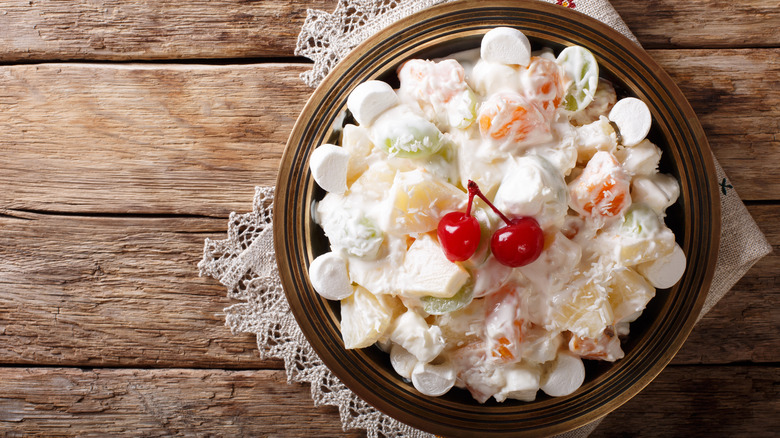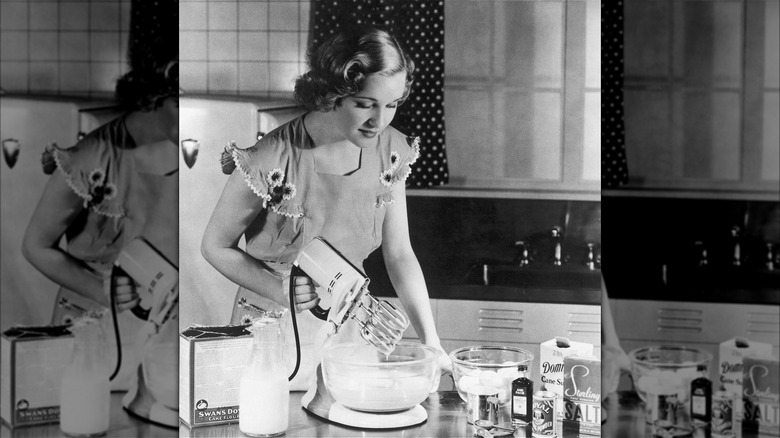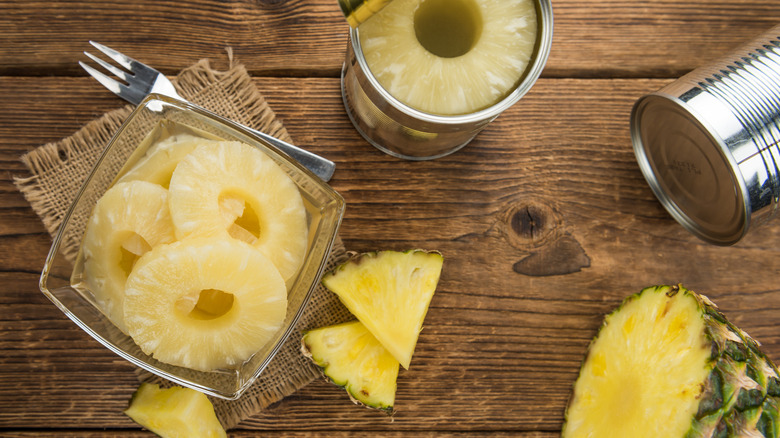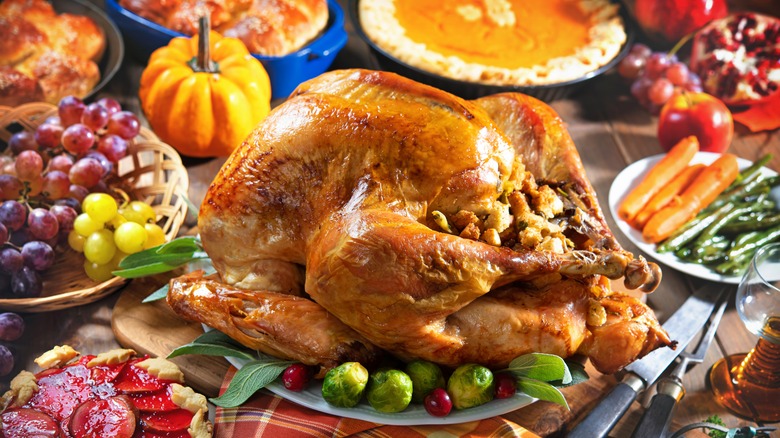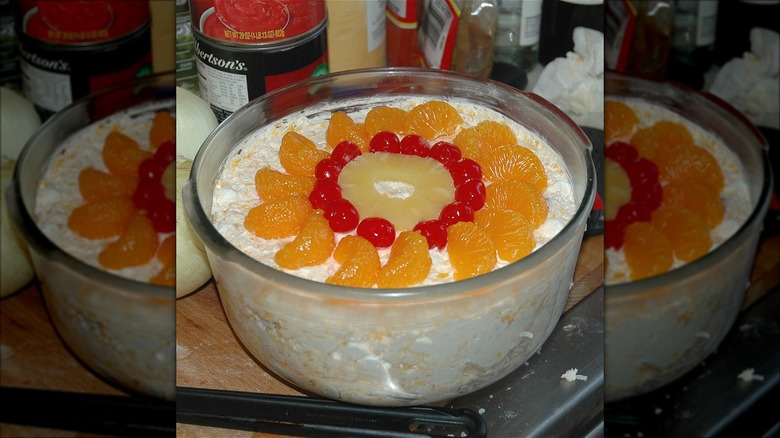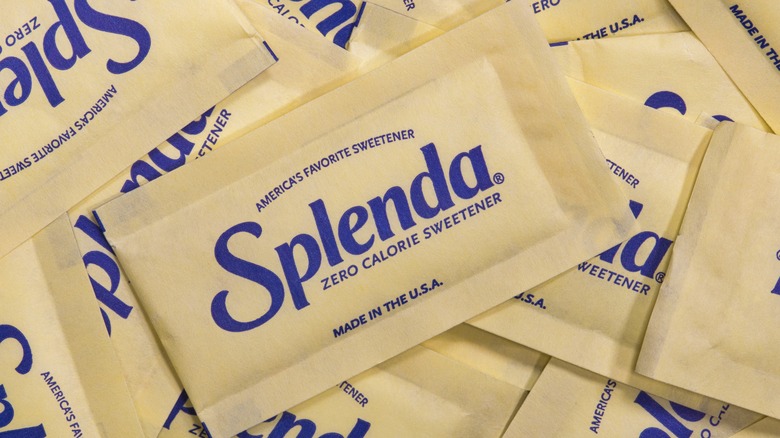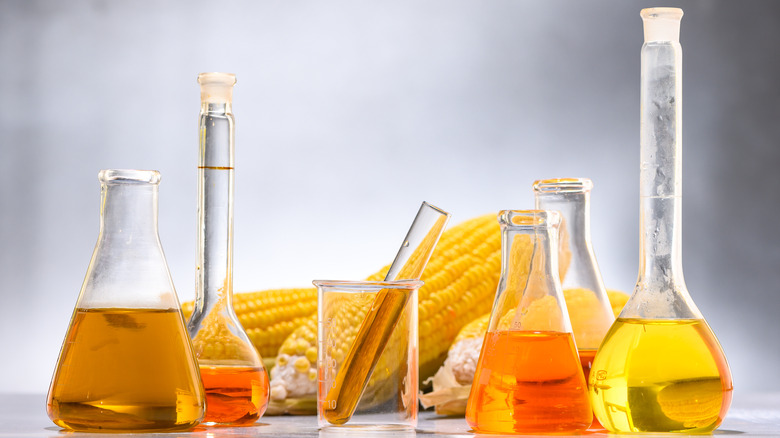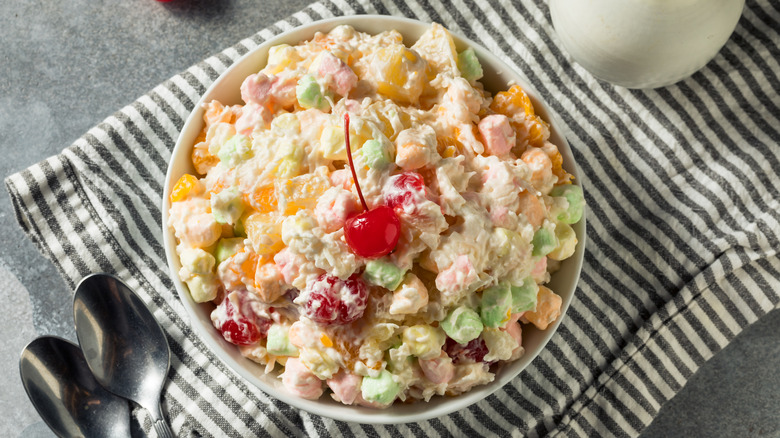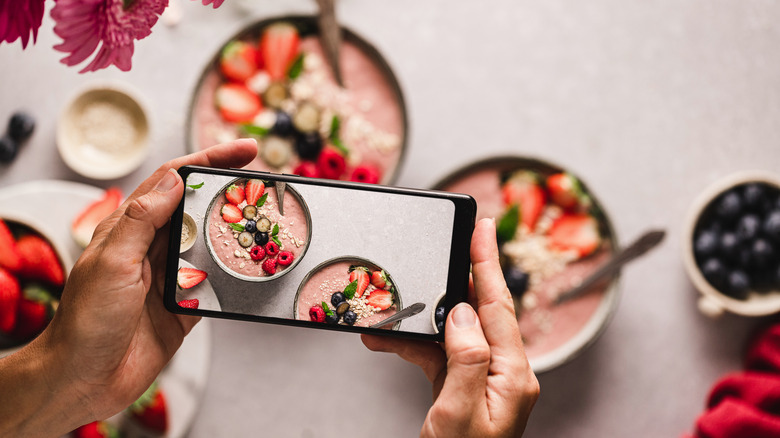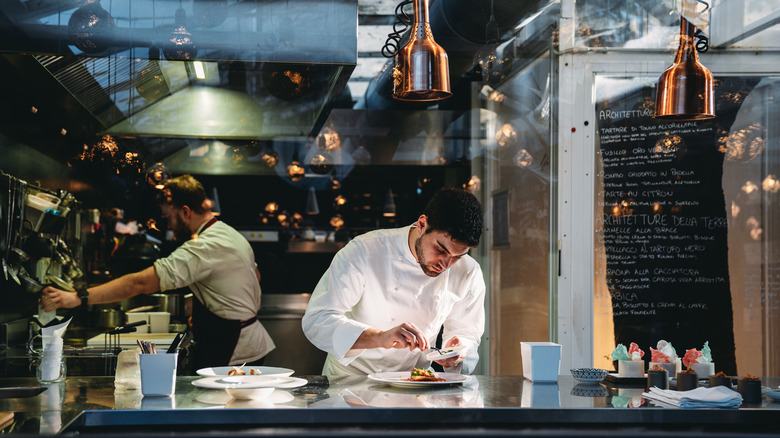Whatever Happened To Ambrosia Salad?
Depending on where you grew up, the mention of ambrosia salad will either summon a cascade of memories or draw a blank. In the South, this not-really-a-salad salad was a fixture of holiday gatherings, and like the desert-dry fruitcake, was one of those polarizing dishes that never seemed to go away no matter how many of your family members complained about it. Named after the food of the Greek gods, ambrosia salad comes in many variations, but the most common combination includes shredded coconut, canned pineapple chunks, mini marshmallows, mandarin oranges, and either sour cream, Cool Whip, or whipped cream. Maraschino cherries are a popular addition that lends some much-needed color, and many cooks add grapes, pecans, and apple slices.
Despite its oddly harmonious flavors and long-standing tenure on potluck tables, this gem of Southern cuisine has faded in recent years. Instead of being a familiar part of holiday celebrations, it is largely relegated to nostalgia status. Like other relics of the 20th century, be it the miraculously versatile Jell-O salad or the calorie bomb fondue, ambrosia salad is more of a novelty these days than a go-to recipe. So, whether you're mourning its scarcity, or only know it as the pink sludge that the neighbor Joyce shoveled into Johnny Depp's mouth in "Edward Scissorhands," keep reading to discover how it became so popular and how it lost its way.
It was all the rage throughout most of the 20th century
Ambrosia salad had its heyday in the 1900s, and its many iterations reflected some of the emerging innovations in the food world. Its popularity took off in the 1920s when the Philadelphia-based confectionary Stephen F. Whitman & Son paid food columnists to subtly advertise its newly invented marshmallow whip. In a move not unlike brands paying social media influencers to rave about their products today, the company secured rave reviews from trusted sources. Recipes for ambrosia salad that included the marshmallow substance began appearing in newspapers. By the time individually shaped marshmallows hit the scene in the same decade, the flavor was inextricably linked to the dish.
Over time, home cooks dabbled in incorporating modern additions such as condensed milk and fruit-flavored gelatin, but Cool Whip was the one that stuck. Created by General Foods (now part of Kraft Heinz) in 1966, this extra fluffy alternative to homemade whipped cream saved time, and had a sugary flavor all its own. It quickly became the foundation for other sweet salads of the era like Watergate salad, and it was a natural fit for ambrosia salad. All the way up through the '70s and '80s, this decadent dish could be found in many a Southern household, proving its adaptability and long-term appeal.
Its origins date back much further
The dessert peaked in the 1900s, but its history dates back even further. The first ambrosia recipe is attributed to Maria Massey Barringer, a North Carolinian author whose 1867 cookbook "Dixie Cookery: A Practical Cook-Book For Southern Housekeepers" contains just three and a half lines of text under the heading "Ambrosia." It's a bare-bones recipe that only involves grated coconut, sugar, and pulped oranges. Aside from the omission of cream, it sets out the basic components of what the dish would become — sweet, citrusy, and crunchy from the coconut.
One of the reasons ambrosia salad may have been so popular in the latter half of the 19th century was that its ingredients were exciting and new. Recently built railroads connected Florida, the orange-growing capital of the country, with the rest of the states, and also ferried coconuts across the U.S. from California where they were brought on ships from the Pacific Islands and South America. A salad made of oranges, sugar, and grated coconut may not sound particularly adventurous today, but in post-Civil War America, its flavors were exotic symbols of the country's new connectivity and culinary variety. In the 1880s, the introduction of tropical pineapple added an extra layer of exotic allure. Cream was soon added, possibly as a counterbalance to the fruits' tanginess.
The ingredients do not have the exotic glamor they once did
One of the reasons that ambrosia salad fell out of favor may be due to the eventual pervasiveness of its once-novel ingredients. Oranges, coconut, and pineapple became so popular in the U.S. that they are now available almost everywhere. You can find oranges in just about any grocery store in America, and coconut has become a multi-purpose kitchen staple, whether you're sprinkling it on your cereal, or using the oil as a rich vegan alternative to butter.
Pineapple is also readily available. In its canned form, it seems like more of a relic of the past these days than an ingredient that transports you to an island in the sunny Pacific. Even marshmallows were exotic in the early 20th century, and when pre-whipped toppings like Cool Whip hit grocery store shelves in the 1960s, there was something deliciously modern about throwing together a colorful dessert with nothing but pre-packaged items.
Now, however, you can walk into a Trader Joe's or Kroger and find açai, halloumi, matcha, and all manner of ingredients that originate from other countries but have become standard items on American shopping lists. By comparison, fruit salad with cream just isn't all that exciting anymore. Especially when most of the ingredients come from a can.
It's still not clear what course it belongs in
Ambrosia salad is often served at buffet-style holiday parties, making it easier to gloss over the fact that there is no consensus about whether it's a dessert or a side dish, even though any home cook worth their salt will have a pretty strong opinion one way or the other. Is it a decadent alternative to cranberry sauce that belongs next to the turkey, or a colorful dessert that belongs next to the pumpkin pie and Yule log?
Neither of these options is satisfying. The reason cranberry sauce works so well with savory flavors is not just a simple matter of sweetness. Its tartness is a natural palate cleanser that cuts through the richness of the rest of the meal, while the texture adds a hint of moisture to the unavoidably dry turkey. Ambrosia is sickly sweet in comparison, and the creamy sauce provides no contrast to the creaminess of mashed potatoes and gravy.
The dessert table is not an obvious choice either. Ambrosia has too much cream and sugar to qualify as a healthy alternative to pie and cake, but its resemblance to a fruit salad prevents it from being a Thanksgiving-worthy guilty pleasure. If you're planning to indulge your dessert cravings over the holidays, ambrosia salad probably isn't what you're fantasizing about. In short, it's a tough dish to categorize, and no matter where to put it in the buffet, someone is going to end up feeling short-changed.
It's a hard sell if you haven't tasted it
Marshmallows, coconut, pineapple chunks, mandarin oranges, and some kind of cream are the basic ingredients in ambrosia salad, and if that doesn't immediately make you start salivating, you're not alone. At first glance, this ingredient list raises a few questions. Is this salad watery from the fruit juice? Does the whipped cream deflate and harden? Is the desiccated coconut adding any flavor or does it just multiply the chewing time? Even more questions abound when considering that some cooks use mayonnaise instead of dairy.
The answers depend on the recipe and preparation. If you don't drain the fruit thoroughly, it can lead to an unappetizing puddle at the bottom of the bowl. If there isn't enough whipped cream or the cream is over-whipped, it can harden into a dense, stale coating. And depending on how you feel about coconut, that added texture might be a nuisance rather than a delightful contrast. Unlike the ingredients in tiramisu or black forest cake, the components of ambrosia salad are not obviously harmonious on paper, which might prevent those who haven't tried it from giving it a whirl. We're happy to declare that, with the right proportion of ingredients, ambrosia salad comes together into something that is not only greater than the sum of its parts, but something that is indeed fit for the gods. But it still takes a leap of faith to give it a try.
It ran afoul of the low-fat, high-fiber craze in the '80s
In the mid-20th century, Americans had an "anything goes" approach to food. Jell-O, Spam, and that spray can imitation of cheese called Snack Mate were all considered fit for human consumption, and no one batted an eye when banana and meat started showing up to dinner as a pair. But the '80s put an end to this hedonism. Saturated fat and natural sugars were out. Aerobics and bran flakes were in. Part of this seismic shift in the American diet was due to the government's introduction of dietary goals in 1977. In the interest of reducing heart disease, the guidelines urged Americans to eat less fat. Its claims that fat was inherently bad for health have since been debunked (per BMJ), but the damage was done. Jogging and unitards took the country by storm, and grocery stores overflowed with fat-free diet foods.
Products that had once delighted consumers–whipped cream, canned fruit, and desiccated coconut, for example, were thrown out in favor of Snackwell's, Splenda, and fat-free Cool Whip. For an era obsessed with low-fat, low-sugar products, the creamy, sugary decadence of ambrosia salad was more of an embarrassing reminder of an uninformed past than a symbol of the health-conscious present. It didn't stop people from eating it, but it probably contributed to the overall impression that the salad was an old-timey relic.
Consumers started avoiding corn syrup
If you look down the ingredients list of marshmallows, maraschino cherries, and Cool Whip (three common ingredients in ambrosia salad), you'll probably see high fructose corn syrup somewhere near the top. This wasn't a red flag in the '70s and '80s, but these days, many consumers avoid the processed sweetener.
In the 1970s, the cost of cane sugar and sugar beets was skyrocketing due to tariffs and quotas that the U.S. government imposed on international imports. With a sharp increase in demand for sugar, American manufacturers started looking for a cheap alternative. High fructose corn syrup, a newly discovered chemical conversion of the glucose in cornstarch to fructose, was their dirt-cheap saving grace. By the 1980s, Coca-Cola had joined just about every other processed food manufacturer in switching to the miracle ingredient.
In the early 2000s, research began to quell the frenzied demand for the cheap sugar alternative. High fructose corn syrup, scientists revealed, increases your appetite, triggers cholesterol production, and compromises the intestinal lining (per Cleveland Clinic). As a result, Americans' consumption of corn syrup fell 11% between 2003 and 2008 (per NBC News). The sweetener became such a pariah that, in 2010, the Corn Refiners Association unsuccessfully petitioned the Food and Drug Administration to rename high fructose corn syrup "corn sugar." This dawning awareness of the drawbacks of the ingredient may have contributed to the decline in foods that, like ambrosia salad, contain a lot of it.
Processed foods are no longer celebrated the way they used to be
In the mid-20th century, ambrosia salad appealed to the newfound joys of culinary convenience. The availability of pre-whipped cream, pulped oranges, and pre-shredded coconut meant that housewives could whip up a batch of the fluffy dessert in only a handful of minutes. How these previously perishable ingredients could all of a sudden have an indefinite shelf-life was secondary to how fully they transformed home cooking. Who cared that Cool Whip didn't have a single dairy ingredient when it could save you from 20 minutes of hand-whipping real cream? Over time, however, consumers started asking questions about processed food, and many did not like what they learned.
Ultra-processed foods are any foods made of ingredients you are unlikely to use at home, such as preservatives, colorings, and all those words on the back of packages that you can't pronounce let alone define. By the time you open a bag of Doritos or shake a can of Reddi Whip, the raw materials have undergone a dizzying number of phases, draining them of their nutrients. This leaves you with high-sugar, high-calorie food that has none of the antioxidants and phytochemicals that make the original ingredients healthy. Consequently, ultra-processed foods have been linked to heart disease, obesity, and type 2 diabetes (per Time), causing many consumers to seek more wholesome alternatives. For anyone trying to avoid these ingredients, the Cool Whip and maraschino cherry salad of their childhood is off the table.
It's still thought of as a regional, homemade dish
Although ambrosia salad was adored by home cooks across the country in the 1800s, it has since become a dish found mostly in the South. The fact that oranges were grown largely in Florida during this period and were therefore readily available in the region may be a factor, but there is no single reason for this shift. Culinary trends may also bear some responsibility. In the early 1900s, around the time ambrosia salad started being labeled as a Southern dish, an influx of immigrants to major U.S. cities was bringing new flavors and cooking styles that diverted tastes away from popular 19th-century fare to a whole new world of culinary variety.
In the 1960s, celebrity chefs like Julia Child and Jacques Pépin not only brought French cooking to the attention of a broader swathe of the American public, but made it accessible. All of a sudden, home cooks across the country were whipping up bavarois and crème brûlée in their own kitchens, and home-grown dishes like ambrosia salad could not compete with their perceived sophistication.
Although none of these factors can fully explain the association that grew between ambrosia salad and the South, they likely played a role. And even as Southern food has seen a spike in popularity in recent decades, ambrosia salad, with its quaint associations with housewives and grandmothers, maintains a vanishingly low profile outside the region.
It isn't particularly photogenic
Setting aside such practical considerations as health and culinary tradition, let us consider the real elephant in the room: If you saw ambrosia salad on a dating app, you definitely wouldn't swipe right. It has neither the sexiness of a molten chocolate lava cake nor the complexity of a many-layered parfait. It is a shapeless, fluffy mass punctuated by mostly unidentifiable lumps, and unless you already know what you're getting, you'd probably take a hard pass.
Like it or not, living in the 21st century means that we are being constantly bombarded with meticulously staged images of food. A 2017 poll found that 69% of millennials take a photo or video of their meals before eating (via HuffPost), and as of this writing, more than 302 million posts on Instagram are tagged with #foodporn. On TikTok, the hashtag has over 35 billion views. We can't get enough of pictures of unicorn Frappuccinos and strawberry glazed donuts. Ambrosia salad, on the other hand, is another story. Until someone solves its aesthetic problem, you can't expect it to go viral.
Perhaps if someone made a version of ambrosia salad with distinct layers of glistening fruit and creamy Cool Whip to show off its ingredients, it might see a rise in popularity. In its classic guise, however, it lacks the vibrancy, definition, and camera-ready drama that we've come to expect from our desserts. Delicious? Absolutely. But that hardly matters when you need a decent photo before digging in.
It's still waiting for a 21st-century makeover
Retro foods are constantly getting reinvented and reintroduced to new generations of eaters. Whether it's canned baked beans, meatloaf, or donuts, up-and-coming cooks are full of innovative ideas for reimagining old favorites. But ambrosia salad remains hopelessly dated. There's no corner of social media dedicated to a matcha version or a recent cookbook full of fresh variations on the classic recipe. You're much more likely to find the salad on the menu of a retro 1950s diner than the latest culinary hotspot in a major city.
Like other dessert salads from the '70s such as Watergate salad and the undeniably delicious cranberry fluff, ambrosia is resolutely stuck in the 20th century. That doesn't mean it lacks appeal; on the contrary, its old-fashioned charm is what makes it such a nostalgic dish for many. Nor does it mean that the dessert lacks merit. With its sweet creaminess and bursts of tropical flavor, it hits all the right notes when you're looking for an unexpected alternative to cake or ice cream. All of these factors make it ripe for reinvention. It may not be destined for the meteoric rise of cronuts or cloud bread, but in its own quiet way, ambrosia salad is full of potential, just ready and waiting for a new wave of chefs to discover.
